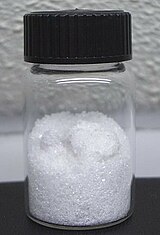
Back Silwernitraat Afrikaans نترات الفضة Arabic گوموش نیترات AZB Сребърен нитрат Bulgarian সিলভার নাইট্রেট Bengali/Bangla Srebro-nitrat BS Nitrat d'argent Catalan Dusičnan stříbrný Czech Кĕмĕл нитрачĕ(I) CV Sølvnitrat Danish
 | |

| |
 | |
| Names | |
|---|---|
| IUPAC name
Silver nitrate
| |
| Systematic IUPAC name
Silver(I) nitrate | |
| Other names
Nitric acid silver(1+) salt
Lapis infernalis Argentous nitrate | |
| Identifiers | |
3D model (JSmol)
|
|
| ChEBI | |
| ChEMBL | |
| ChemSpider | |
| ECHA InfoCard | 100.028.958 |
| EC Number |
|
PubChem CID
|
|
| RTECS number |
|
| UNII | |
| UN number | 1493 |
CompTox Dashboard (EPA)
|
|
| |
| |
| Properties | |
| AgNO3 | |
| Molar mass | 169.872 g·mol−1 |
| Appearance | colorless solid |
| Odor | Odorless |
| Density | 4.35 g/cm3 (24 °C) 3.97 g/cm3 (210 °C)[1] |
| Melting point | 209.7 °C (409.5 °F; 482.8 K)[1][3] |
| Boiling point | 440 °C (824 °F; 713 K) decomposes[1] |
| 122 g/100 mL (0 °C) 170 g/100 mL (10 °C) 256 g/100 mL (25 °C) 373 g/100 mL (40 °C) 912 g/100 mL (100 °C)[2] | |
| Solubility | Soluble in acetone,[1] ammonia, ether, glycerol |
| Solubility in acetic acid | 0.776 g/kg (30 °C) 1.244 g/kg (40 °C) 5.503 g/kg (93 °C)[3] |
| Solubility in acetone | 0.35 g/100 g (14 °C) 0.44 g/100 g (18 °C)[2] |
| Solubility in benzene | 0.22 g/kg (35 °C) 0.44 g/kg (40.5 °C)[2] |
| Solubility in ethanol | 3.1 g/100 g (19 °C)[2] |
| Solubility in ethyl acetate | 2.7 g/100 g (20 °C)[3] |
| log P | 0.19 |
| −45.7·10−6 cm3/mol | |
Refractive index (nD)
|
1.744 |
| Viscosity | 3.77 cP (244 °C) 3.04 cP (275 °C)[3] |
| Structure | |
| Orthorhombic, oP56[4] | |
| P212121, No. 19[4] | |
| 222[4] | |
a = 6.992(2) Å, b = 7.335(2) Å, c = 10.125(2) Å[4] α = 90°, β = 90°, γ = 90°
| |
| Thermochemistry | |
Heat capacity (C)
|
93.1 J/mol·K[1] |
Std molar
entropy (S⦵298) |
140.9 J/mol·K[1] |
Std enthalpy of
formation (ΔfH⦵298) |
−124.4 kJ/mol[1] |
Gibbs free energy (ΔfG⦵)
|
−33.4 kJ/mol[1] |
| Pharmacology | |
| D08AL01 (WHO) | |
| Hazards | |
| Occupational safety and health (OHS/OSH): | |
Main hazards
|
Reacts explosively with ethanol. Toxic. Corrosive. |
| GHS labelling: | |
    [5] [5]
| |
| Danger | |
| H272, H314, H410[5] | |
| P220, P273, P280, P305+P351+P338, P310, P501[5] | |
| NFPA 704 (fire diamond) | |
| Lethal dose or concentration (LD, LC): | |
LDLo (lowest published)
|
800 mg/kg (rabbit, oral) 20 mg/kg (dog, oral)[6] |
Except where otherwise noted, data are given for materials in their standard state (at 25 °C [77 °F], 100 kPa).
| |

Silver nitrate is an inorganic compound with chemical formula AgNO
3. It is a versatile precursor to many other silver compounds, such as those used in photography. It is far less sensitive to light than the halides. It was once called lunar caustic because silver was called luna by ancient alchemists who associated silver with the moon.[7] In solid silver nitrate, the silver ions are three-coordinated in a trigonal planar arrangement.[4]
- ^ a b c d e f g h Lide, David R., ed. (2009). CRC Handbook of Chemistry and Physics (90th ed.). Boca Raton, Florida: CRC Press. ISBN 978-1-4200-9084-0.
- ^ a b c d Seidell, Atherton; Linke, William F. (1919). Solubilities of Inorganic and Organic Compounds (2nd ed.). New York City: D. Van Nostrand Company. pp. 617–619.
- ^ a b c d Kiper, Ruslan Anatolievich. "silver nitrate". Chemister.ru. Retrieved 2014-07-20.
- ^ a b c d e Meyer, P.; Rimsky, A.; Chevalier, R. (1978). "Structure du nitrate d'argent à pression et température ordinaires. Exemple de cristal parfait". Acta Crystallogr. B. 34 (5): 1457–1462. Bibcode:1978AcCrB..34.1457M. doi:10.1107/S0567740878005907.
- ^ a b c Sigma-Aldrich Co., Silver nitrate. Retrieved on 2014-07-20.
- ^ "Silver (metal dust and soluble compounds, as Ag)". Immediately Dangerous to Life or Health Concentrations (IDLH). National Institute for Occupational Safety and Health (NIOSH).
- ^ "Definition of Lunar Caustic". dictionary.die.net. Archived from the original on 2012-01-31.
